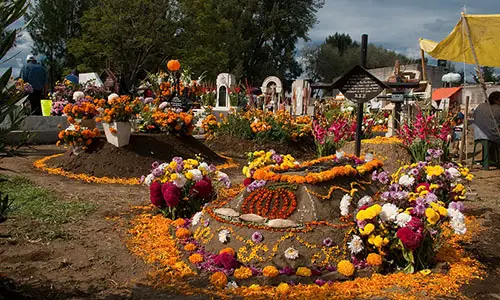1. Day of the Dead is called Dia de los Muertos
Day of the Dead is also known as Dia de los Muertos, a festival observed between 31st October and November 2nd by Mexicans and people in South and Central America. This festival is increasingly observed across the United States in states like Texas and California where American and Mexican heritage exists.
2. Not a Scary or Sad Occasion
The Day of the Dead festival is not necessarily a scary or sad affair. Instead, it is a spirited festival where people honor and remember family members who have passed on. This festival is based on the belief that death is a natural part in life and it is not something to be afraid of.
3. Home Celebrations
Day of the Dead celebrations are often held in homes where people create alters known as Ofrendas in Spanish. These altars display favorite foods, portraits and special possessions of dead loved ones. Marigolds and candles are used to decorate the altars. Light from candles as well as cempasuchit, which is scent from flowers, are known to attract deceased souls and bring them back to enjoy the pleasures they once liked for a short time.
4. Visits to Grave Sites
Families of deceased persons visit grave sites of their loved ones where they clean headstones, bring music and decorate the graves with flowers. Sometimes the possessions of the deceased and their favorite foods are brought to the grave sites too. Families also enjoy picnics with deceased person’s favorite foods and interact with others at grave sites.
5. A Pre-Colombian Ritual
Day of the Dead has its roots in pre-Colombian era. Most practices and symbols are derived from indigenous groups such as Aztec and Maya of Meso America. It is celebrated in countries that are populated by people of Latino background including Ecuador, Mexico, Guatemala and other South and Central America countries.
6. Symbols of Day of the Dead
The major symbols of Day of the Dead holiday are skeletons, skulls and marigolds. In many places, outdoor markets are used to sell different items including special breads, pottery, flowers, baskets, paper puppets, candy skulls, and candles. Skeletons and skulls are displayed across cities and sites of skeletons marching, hugging, laughing and dancing are commonly seen on the streets.
7. The term Death is Uncommon in London and New York
According to native Mexican and Nobel Prize winner, Octavio Paz, the term death is not frequently used in cities like London, New York and Paris. On the contrary, Mexicans are familiar with death; they joke about it and celebrate it.
8. Day of the Dead Festivals coincide with All Souls and All Saints Day
The dates when Day of the Dead festival is held coincide with Catholic celebrations for the All Souls Day and All Saints Day. This coincidence is as a result of efforts by the Catholic Church to establish the similarities between Christian and indigenous beliefs. Day of the Dead festival is upheld as the most crucial holiday in Mexico.
9. Todos Santos
The period when the Day of the Dead is celebrated, 31st October to 2nd November, is known as Todos Santos. This time when the dead are remembered is a vital social ritual among Latinos that they consider a way of appreciating the cycle of life as well as death in human existence.
10 . Children souls return first
It is believed that the souls of dead children, also called angelitos, return first. Gifts and foods appropriate for them are prepared in miniature sizes. Souls of adults are believed to return on 1st November; elaborate drinks and foods are prepared for them. According to folktales, dead spirits revenge poor treatment on these days.











Leave a Reply